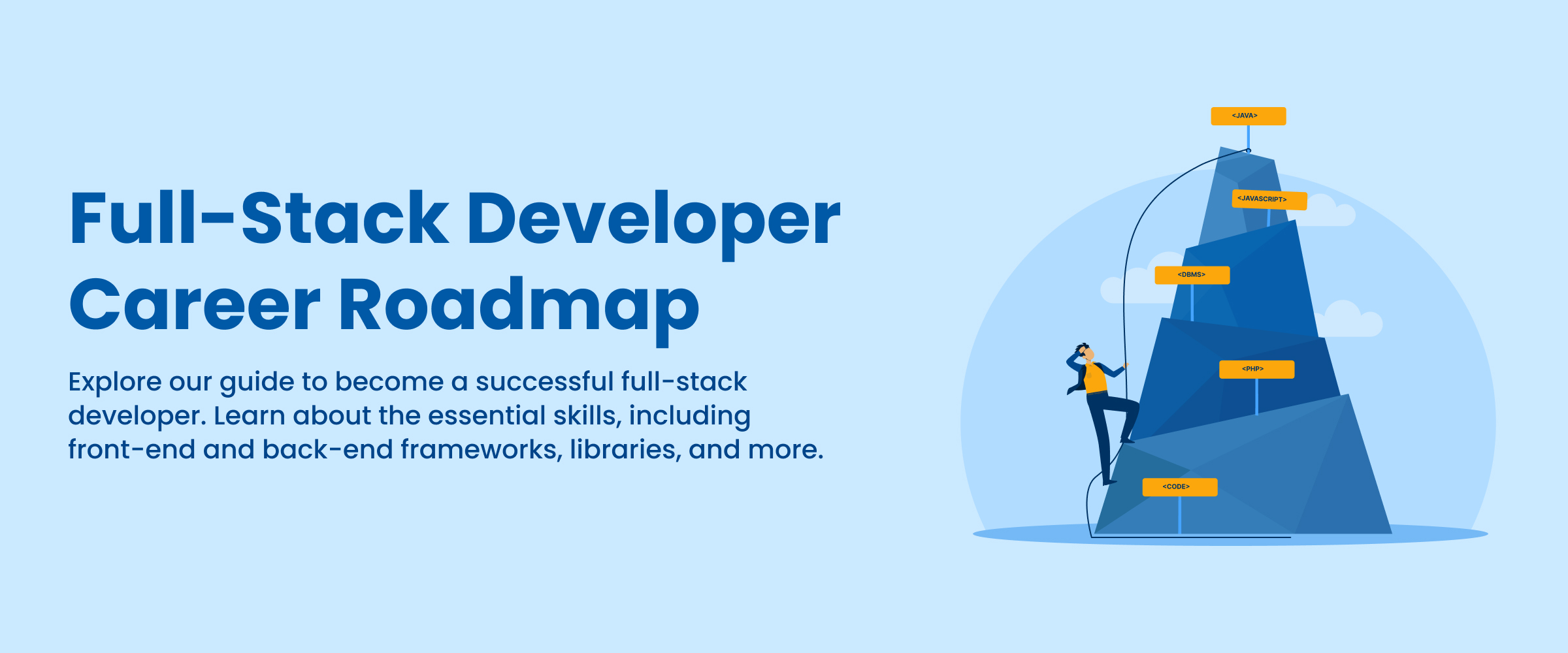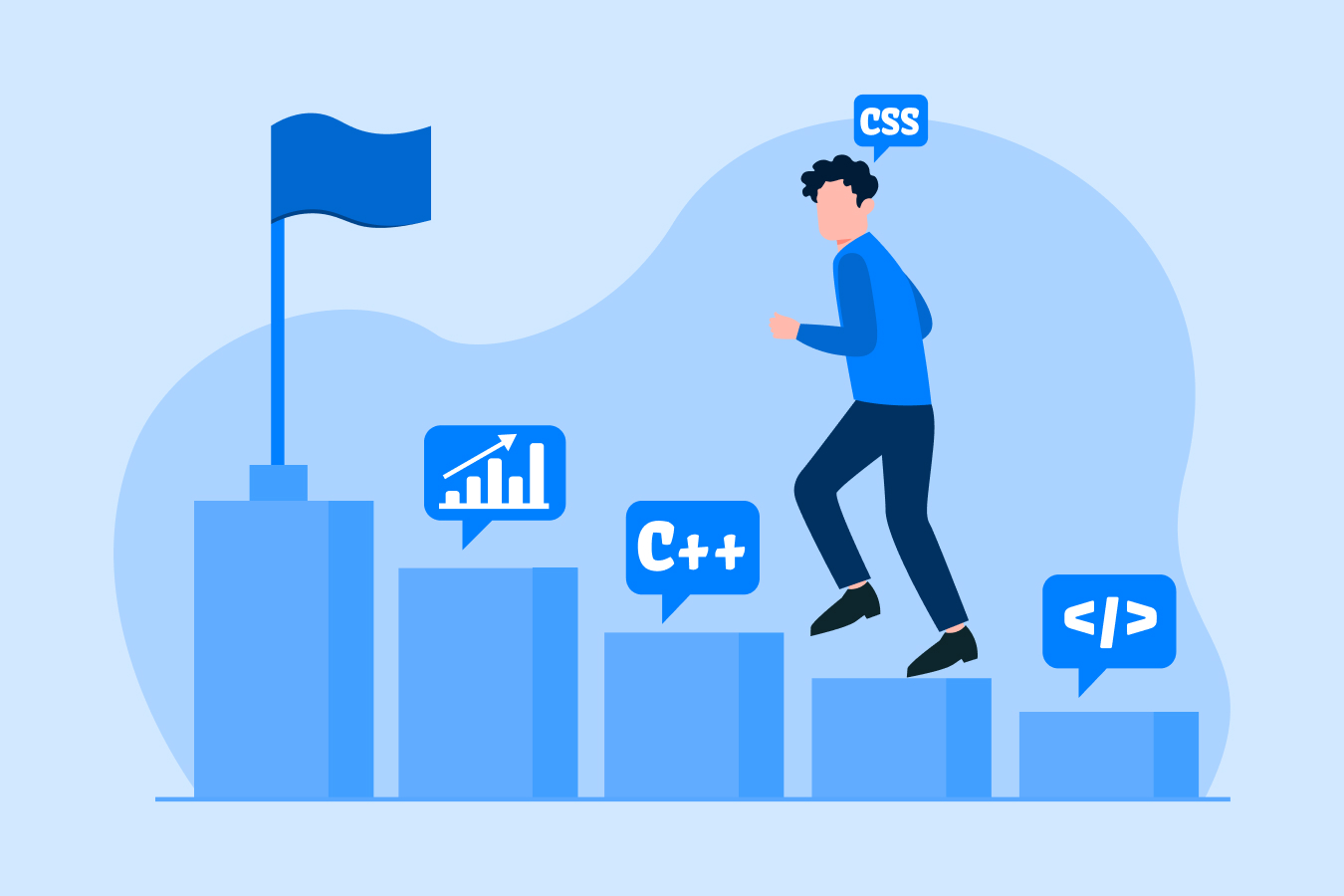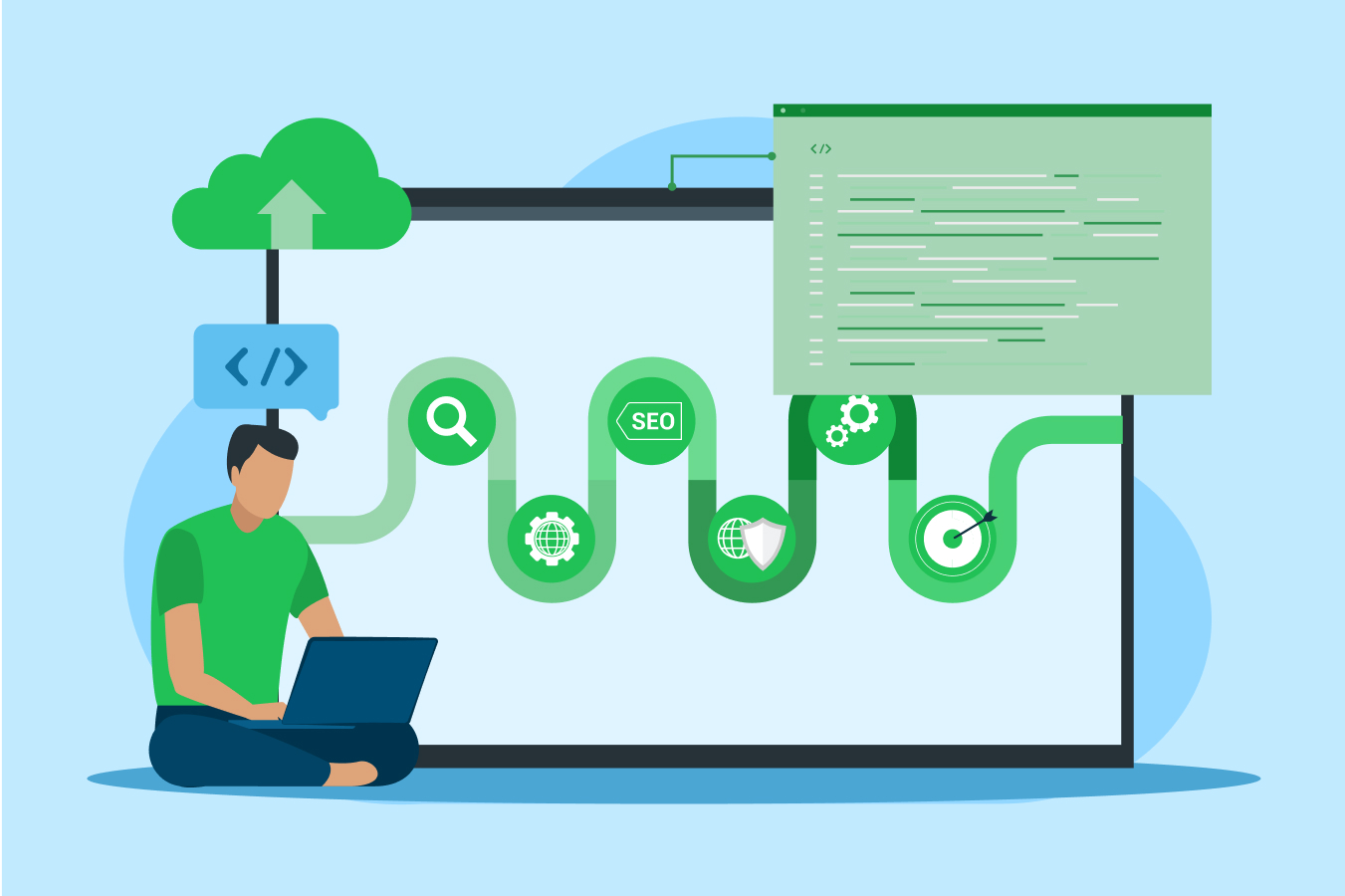Full Stack Developer Roadmap: A Guide for Building Your Career in 2025
Full-stack development is the backbone of modern web and application development. It encompasses front-end and back-end technologies. Full-stack developers manage the entire spectrum of projects, including user interface design, server-side logic and development, etc. The role’s versatility has spurred the demand for developers in the tech industry. Becoming a full-stack developer is a great and lucrative career option for tech enthusiasts.
This blog explores the full-stack developer roadmap and outlines the required skills, knowledge, and experience to become an expert. With the help of the roadmap, aspiring developers can navigate their learning journey with clear goals and objectives.
Who is a Full-Stack Developer?
A full-stack developer is a professional with in-depth front-end and back-end development knowledge. They are skilled in Java, Python, HTML, and CSS. They also possess knowledge of multiple frameworks like Node.JS and Django and work with different database management systems.
These professionals design user interfaces, write code scripts, set up databases, and manage servers. Additionally, they possess time management and problem-solving skills that enable them to tackle various aspects of web development projects independently. If you wish to start a career in this field, you can take up a full-stack development course with placement to learn the essentials of front-end and back-end development while landing a promising job opportunity.
Full Stack Web Developer Roadmap: A Steps-By-Step Analysis
To succeed as a developer you need a road map to guide you through your journey. Full-stack developers have comprehensive knowledge and skills ranging from programming languages to version control, which enables them to create complete web applications from start to finish. Here is a complete roadmap on how to become a full-stack developer with no experience.
A roadmap is essential to start a career and guide you through your journey. Full-stack developers have comprehensive knowledge and skills ranging from programming languages to version control, which enables them to create complete web applications from start to finish. Here is a complete roadmap on how to become a full-stack developer with no experience.
1. Learn the Fundamentals: Back to Basics!
To become a proficient full-stack developer, start with the web development essentials. Gain a solid understanding of HTML, CSS, and JavaScript. These programming languages form the backbone of every website. Consider taking an online web development course to brush up on your basics. Here is a structured breakdown of key concepts to focus on:
i. HTML
HTML (HyperText Markup Language) is the foundation of web development. It is used to structure content with elements and tags. You can create a basic website with just HTML. To master HTML, focus on the following key concepts:
- Semantic and Non-Semantics
- HTML Basics
- HTML Forms
- HTML Tags
- HTML Tables
- HTML Lists
- HTML Graphics
- HTML Attributes
- HTML DOM
- HTML 5
- HTML APIs
- HTML Audio/Video
- HTML 5 MathML
ii. CSS
CSS (Cascading Style Sheets) allows you to style and format web pages, adding colors, layouts, and animations. Before diving into frameworks like Bootstrap or Tailwind CSS, focus on the following core concepts:
- CSS Borders
- CSS Colors
- CSS Height and Width
- CSS Align
- CSS Margins and Paddings
- CSS Tables
- CSS Lists
- CSS Grid
- CSS Flex
- CSS Z-index
- CSS Box-Model
- CSS DropDown
- CSS Transitions
Pro Tip: Learn more CSS elements, text styling, syntax, and more, with our guide – ‘CSS Cheat Sheet.’
iii. JavaScript
JavaScript is the core programming language for web interactivity. It enables dynamic features like animations, form validation, and real-time updates. Mastering JavaScript is essential for modern web development. Focus on the following key topics:
- JS Operators
- JS Basics
- JS Debugging
- JS Loops
- JS String Methods
- JS Math Object
- JS Array Methods
- JS Boolean and DataView
- JS Date Object
- JS Advance
- JS Form
- DOM
Pro Tip: Want to strengthen your programming skills further? Enroll in our Core Java course to build industry-relevant expertise.
2. Gain Knowledge of Version Control
Understanding version control is crucial to ensure the code is securely stored in a remote repository such as GitHub and AWS CodeCommit. Git, the industry standard for version control software, relies on command-based operations and has widespread usage. Acquiring version control skills can help you coordinate, share, and collaborate efficiently with your team. This is useful to track changes and identify errors in a software, website, or application.
3. Master Front-End Development Technologies
Becoming a skilled full-stack developer requires a comprehensive understanding of front-end development tools such as HTML, CSS, JavaScript, etc. Being proficient in these languages is crucial because:
- HTML helps in creating the structure of the web page. This ensures users get to interact with an intuitive interface.
- CSS allows developers to define and apply styles consistently on their website. This makes it easier to update and maintain the design.
- JavaScript is crucial because of its ability to work with both front-end and back-end. This enables the developers to reuse code that follows similar logic and implementation, simplifying the development process.
- Frameworks like React, Angular, or Vue.js enable developers to create dynamic and interactive web applications. With these frameworks, the developers can implement complex features like routing, dependency injection, and data binding.
- Redux or MobX are state management libraries used in web applications to monitor the state on the front end. They maintain and update data across applications while remaining independent of its components.
4. Acquire Back-end Development Skills
A proficient full-stack developer should possess comprehensive knowledge of back-end development tools, including the following:
- Programming Languages: Java or Python are essential for full-stack development. The simplified syntax and different features are compatible with high-level object-oriented programming.
- Web Servers: Full-stack developers should have in-depth knowledge of Apache, Nginx, and Microsoft’s Internet Information Server (IIS). They are essential for processing and managing HTTP requests from the client system.
- Databases: Developers should be able to handle data from databases like Oracle, SQLServer, MySQL, PostgreSQL, and MongoDB. Efficient and organized databases are crucial for storing user information, providing dynamic content, and performing transactions. Database management systems impact the performance and scalability of an application.
- APIs: Application programming interfaces integrate new applications with existing software systems. They streamline the development process and enhance the functionality of the application.
- Node.js: This is an open-source development technology that is important for creating fully asynchronous applications. It enables the developers to unify the application development for easy and quick maintenance.
- Django and Ruby on Rails: You should explore these back-end frameworks and libraries to simplify common tasks, such as authentication, caching, and job queues.
Enroll now for hands-on training, personalized mentorship, and guaranteed placement assistance. Learn all the latest skills with full stack developer course with placement and start your journey.
5. Learn How to Integrate Front-End & Back-End Components
To excel as a full-stack developer, you need an in-depth understanding and expertise in various front-end and back-end components. These include user interface components, caching mechanisms, and cloud services. Additionally, proficiency in client-server communication protocols such as HTTP, WebSockets, and GraphQL is required to build responsive and dynamic applications.
Pro Tip: Check out the following blogs to learn more about learning front-end and back-end development technologies and using them together in a project:
6. Familiarize Yourself with Scalability and DevOps
Familiarize yourself with the following technologies and processes:
- Deployment methods and technologies such as Docker and Kubernetes.
- Continuous Integration/Continuous Deployment (CI/CD) strategies for streamlining, building, and deploying processes through automation.
- Secure authentication processes, proper authorization methods, and appropriate handling of sensitive data within web applications.
7. Build Your Skills – Skill Up!
To excel as a full-stack developer, it is vital to cultivate important soft skills and technical expertise. Here are some of the soft skills essential for a full-stack developer and ways to enhance them:
- Problem-Solving Skills: You can participate in hackathons, practice coding challenges, and do live projects to improve your problem-solving skills.
- Critical Thinking Skills: Puzzle-solving, case study analysis, and reading insightful blogs can help you enhance critical thinking skills.
- Communication Skills: Join a coding community, practice active listening, and participate in code reviews to improve your communication skills.
- Collaboration Skills: Engage in cross-team projects, attend workshops to network with like-minded professionals, and engage in team-building activities to work on your collaboration skills.
8. Develop and Create Projects
Demonstrate proficiency in developing full-stack applications and problem-solving by working on web development projects. You can include practice projects in your portfolio to showcase your skills and catch the attention of potential employers. These projects will help to highlight your experience level and area of expertise so the recruiter can easily analyze your skillset. If you are a fresher, these projects are useful in showcasing that you actively take initiative to work and are passionate about your field.
9. Stay Updated with Industry Trends
Try to stay updated on the current trends, technologies, and best practices in web development through activities such as coding challenges, discussions, and hackathons. Also, actively contribute to open-source projects for continuous growth and improvement. Staying updated with industry trends helps you to stand out in a competitive job market. Further, you gain insights about in-demand skills and job openings, both essential for professional development.
10. Choose Between Popular Technologies
Full-stack development involves handling the front-end, back-end, and database management of an application. The choice of technology depends on individual preferences, project requirements, and specific use cases. Here are some popular and in-demand technologies you can consider working with:
- MERN: MERN is a JavaScript-based web development stack. It includes MongoDB, Express, React, and Node. It is widely used for creating dynamic websites and web applications. The MongoDB is a NoSQL database that deals with data and Express handles PUT, GET, DELETE, and POST functions for NodeJS. On the other hand, React is a JavaScript library typically used for user interfaces and single-page applications, and NodeJS is an open-source server.
- MEAN: MEAN works with the Angular framework and is written in TypeScript. MEAN, which stands for MongoDB, Express.js, AngularJS, and Node.js, is a full-stack JavaScript framework commonly used for building cloud-ready applications.
11. Become Proficient in Database
A database is a structured collection of data that allows users to store and retrieve information efficiently. There are two main types of databases: relational (SQL) and non-relational (NoSQL). Some popular databases include:
- MySQL: MySQL is a relational database management system that stores and manages data.
- MongoDB: MongoDB is a NoSQL database that supports key-value storage and graph databases.
- VoltDB: It is a relational database that stores data in memory for faster processing.
Pro Tip: Explore more about databases with our following blogs:
Future Scope of Full-Stack Web Development
There will be numerous opportunities for professionals to explore. To leverage career growth opportunities, it is crucial to understand the future trends in the industry. Here are some of the trends important for the full-stack developer industry:
- There is a wide acceptance of new technologies like AI, ML, blockchain, and the Internet of Things (IoT) creating immense demand for full-stack developers.
- With the changing educational environment, individuals with valuable certifications will be eligible for full-stack developer roles. Degrees may not be mandatory as employers will focus on skill-based hiring.
- There will be a rise in remote work and freelancing opportunities as several companies shift to the hybrid mode.
- Mobile applications are increasingly becoming popular. Therefore, cross-platform development will become a trend. Progressive web apps are also coming up as a cost-effective alternative to native mobile apps to provide a better user experience.
- With increased security concerns, cybersecurity will be a skill that employers may look for in prospective developers.
Conclusion
Our full-stack developer roadmap is a comprehensive guide with essential steps an aspiring developer should follow. It involves acquiring necessary skills, emphasizing continuous learning, and gaining experience through projects or internships. You can always research more to find new and exciting ways to enhance the results from these steps. Additionally, explore more about top companies or locations that offer work in this domain to know your options.
Which technical or soft skill is the most crucial for a web developer? Share any tips you follow to improve your developer skills in the comment section below. If you’re exploring the web development field and are keen to know about the career path of other roles, check out this guide on how to become a front-end developer.
FAQs
To become a full-stack developer, follow these key steps:
a) Learn Frontend Development: Master HTML, CSS, and JavaScript.
b) Master Backend Development: Gain expertise in server-side languages and frameworks.
c) Understand Databases: Learn SQL and NoSQL databases.
d) Learn Version Control & Deployment: Use Git, GitHub, and cloud services.
e) Work on Projects: Build real-world applications to gain practical experience.
f) Explore Popular Technologies: Familiarize yourself with frameworks like React, Angular, and Node.js.
The MERN stack consists of MongoDB, Express.js, React, and Node.js and continues to be one of the most widely used full-stack development stacks in 2025. It enables developers to build scalable and efficient web applications using JavaScript across the entire stack.
Yes, full-stack development will remain highly in demand in 2030 and beyond. As businesses continue to digitize, companies will require developers who can efficiently manage both frontend and backend technologies, making full-stack developers an invaluable asset.
AI will enhance rather than replace full-stack developers. While AI can automate tasks such as code generation, testing, and bug detection, it lacks human creativity, problem-solving skills, and system design expertise. Instead of replacing developers, AI will boost productivity by handling repetitive tasks and assisting in development.
The average salary of a full-stack developer in India varies based on experience and location. The average salary for freshers is around ₹5 LPA -₹8 LPA, whereas mid-level developers can expect to earn between ₹10 LPA – ₹20 LPA. The experienced developers can earn between ₹25 LPA – ₹40 LPA.






